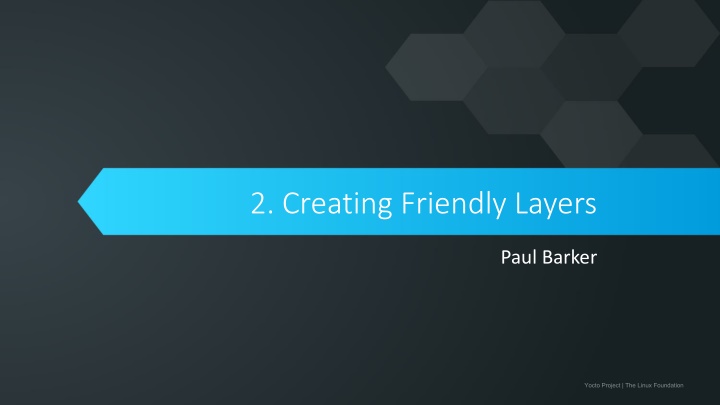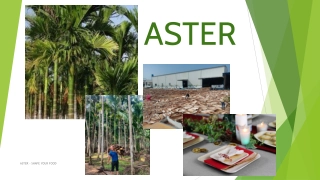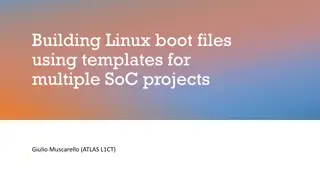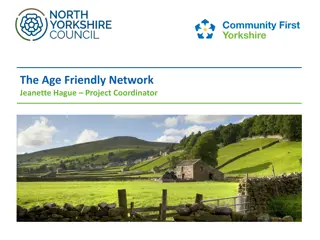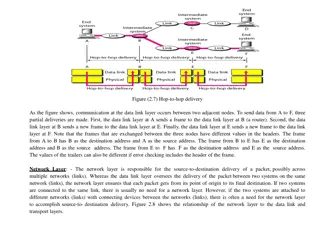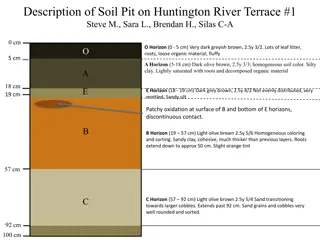Creating Friendly Layers in Yocto Project: Best Practices and Benefits
Learn about creating friendly layers in Yocto Project, best practices, benefits, and why you should care. Understand how to avoid conflicts, simplify development, and improve integration with other layers.
Download Presentation

Please find below an Image/Link to download the presentation.
The content on the website is provided AS IS for your information and personal use only. It may not be sold, licensed, or shared on other websites without obtaining consent from the author.If you encounter any issues during the download, it is possible that the publisher has removed the file from their server.
You are allowed to download the files provided on this website for personal or commercial use, subject to the condition that they are used lawfully. All files are the property of their respective owners.
The content on the website is provided AS IS for your information and personal use only. It may not be sold, licensed, or shared on other websites without obtaining consent from the author.
E N D
Presentation Transcript
2. Creating Friendly Layers Paul Barker
About Me Involved in Yocto Project since 2013 Work across the whole embedded stack Managing Director & Principal Engineer @ Beta Five Ltd Contact: paul@betafive.co.uk Website: https://www.betafive.co.uk/
About This Talk Introduction Best Practices Layers to learn from Methods Examples Parsing details of bblayers.conf and layer.conf files Suggestions for future work
There Shall Be No Victims I won t be showing examples of bad practice today Sorry to disappoint!
What Is A Friendly Layer? Simply adding the layer doesn t change functionality Doesn t assume MACHINE, DISTRO, etc Careful use of bbappends Avoid clashing with recipe names in existing layers Place python helpers in a lib directory Avoid littering the global namespace Well documented
Why Should You Care? Yocto Project Compatible badge requires this Makes it easier to integrate with other layers Less likely to cause conflicts Easier to test and debug builds Can quickly turn features on and off Can reduce the number of layers you need to create Check MACHINE instead of having one layer per machine Check features instead of having one layer per feature Actually simplifies development of your layer
But cant you just dynamically set BBLAYERS? Not in a multiconfig Not based on variables in local.conf or some layer So you may not even know MACHINE, DISTRO, etc Not even very easily in bblayers.conf Parsing limitations discussed later Dynamically creating bblayers.conf for each build means another script to maintain
Layers To Learn From meta-virtualization meta-clang meta-security meta-raspberrypi
Documenting Your Layer You need a README Also add a docs folder at the top level Sphinx (http://www.sphinx-doc.org) is a good choice Can publish to Read the Docs (https://readthedocs.org) Also clearly identify Licensing How to contribute Support forums or email addresses
Keep layer.conf simple Settings in layer.conf apply to all recipes Not just those in your layer Often difficult to override things set in layer.conf Parsed very early Details covered later Parsed in BBLAYERS order not BBFILE_PRIORITY order
Adding New Content in Layers New content is typically safe to add New recipes New classes New machines New distros Watch out for name clashes Search the layer index first: https://layers.openembeded.org/
Modifying Existing Recipes This is where you can cause problems Don t indiscriminately modify variables and tasks Use overrides and conditionals Check MACHINE, DISTRO, feature variables, etc
_remove: Use with caution _remove takes precedence over _append _remove cannot be undone easily! Avoid it if at all possible
Using Overrides Extend OVERRIDES based on a variable Use override syntax in variable assignments Document your new variable For example, if you support option `a` and option `b`: OVERRIDES =. "option-${OPTION} SRC_URI_append_option-a = "file://a.patch" SRC_URI_append_option-b = "file://b.patch file://b.conf"
Example: Toolchain Override in meta-clang In clang.bbclass: # choose between 'gcc' 'clang' an empty '' can be used as well TOOLCHAIN ??= "gcc" OVERRIDES =. "${@['', 'toolchain-${TOOLCHAIN}:']['${TOOLCHAIN}' != '']}" CC_toolchain-clang = "..." CXX_toolchain-clang = "..." CPP_toolchain-clang = "..." CCLD_toolchain-clang = "..." CLANG_TIDY_EXE_toolchain-clang = "..." RANLIB_toolchain-clang = "..." AR_toolchain-clang = "..." NM_toolchain-clang = "..."
Using Features Three classes of feature variables: DISTRO_FEATURES MACHINE_FEATURES IMAGE_FEATURES Much tidier than messing with overrides Conditional syntax isn t very pretty though
Conditional Syntax Python expressions Can call a function `fn` with the syntax `${@fn()}` Two commonly used condition functions oe.utils.conditional def conditional(variable, checkvalue, truevalue, falsevalue, d): if d.getVar(variable) == checkvalue: return truevalue else: return falsevalue bb.utils.contains is `checkvalues` a subset of `variable`? def contains(variable, checkvalues, truevalue, falsevalue, d)
Conditional Inclusion You can use Python expressions in include and require statements Example: require ${@bb.utils.contains('DISTRO_FEATURES', ...)} You can have a simple .inc file without conditionals if you have many changes to make based on one condition
Include vs Require Statements `require` errors on missing files You almost always want this `include` silently ignores missing files Useful for optional configs Useful when including something from another optional layer
Example: Distro Features in meta-virtualization README The bbappend files for some recipes (e.g. linux-yocto) in this layer need to have 'virtualization' in DISTRO_FEATURES to have effect. To enable them, add in configuration file the following line. DISTRO_FEATURES_append = " virtualization linux-yocto_4.19.bbappend require ${@bb.utils.contains('DISTRO_FEATURES', 'virtualization , '${BPN}_virtualization.inc', '', d)} No DISTO_FEATURES conditionals needed in the .inc file
Example: Conditional inheritance in meta-security linux-%.bbappend inherit ${@bb.utils.contains('DISTRO_FEATURES', 'modsign , 'kernel-modsign', '', d)} No DISTRO_FEATURES conditionals needed in kernel-modsign.bbclass
Adding Sanity Checks Add a handler for bb.event.SanityCheck Ensures your check only runs once Raise a flag if things look wrong bb.warn() bb.error() bb.fatal() if you really can t continue Use this if you really must limit supported values of MACHINE, DISTRO, etc
Example: Sanity Checks in meta-virtualization sanity-meta-virt.bbclass addhandler virt_bbappend_distrocheck virt_bbappend_distrocheck[eventmask] = "bb.event.SanityCheck" python virt_bbappend_distrocheck() { skip_check = e.data.getVar('SKIP_META_VIRT_SANITY_CHECK') == "1" if 'virtualization' not in e.data.getVar('DISTRO_FEATURES').split() and not skip_check: bb.warn("...") }
Using Anonymous Python Functions Useful when more complex conditionals are needed Full support for python if statements, for statements, etc Executed at parse time Can use d.getVar() to check variables Can use d.setVar() to modify variables Syntax: python() { if d.getVar('SOMEVAR').startswith('prefix'): d.setVar('SOMEOTHERVAR', '1') }
Using Classes to Modify Recipes Define a new class in your layer Do not set INHERIT in layer.conf or elsewhere Document that your functionality is enabled by adding the new class to INHERIT in local.conf or a distro conf Useful if you have similar modifications to make to many recipes
Modifying BBCLASSEXTEND Appending to BBCLASSEXTEND in a bbappend is relatively safe No need for conditionals here May be used to add `-native` variant of an existing recipe Can then be used in the build of another recipe
yocto-check-layer Script Layer compatibility test script Checks recipe signatures with and without the layer present Also checks for other common requirements: Does the layer have a README? Does everything parse correctly? Is LAYERSERIES_COMPAT set? Can we get signatures for `bitbake world` Actual build is not perfomed
In Summary: Think About Downstream Developers How can they extend configuration? How can they disable things? Don t force them to use _remove Don t assume distro, machine or target image If support really is limited, add a sanity check
Parsing Details: bblayers.conf Parsed first Before any layer.conf Before local.conf or other user config files Before base.bbclass BBLAYERS is iterated as soon as bblayers.conf is fully parsed Can t depend on variables from any of the above files No access to python lib directories from any layer Can t `import oe` or any submodules Can t use oe.utils.conditional(), use bb.utils.contains() instead
Parsing Details: layer.conf Parsed in sequence of BBLAYERS immediately after bblayers.conf Still before local.conf, base.bbclass, etc Still no access to python lib directories from any layer Including the current layer!
Future Work Make it easier to write friendly layers Automate checks against the layer index Catch recipe, machine or class name duplication Nerf layer.conf Simpler conditionals? Encourage more layer documentation Should we standardise here?
Thank You Follow Up: paul@betafive.co.uk Any questions?
